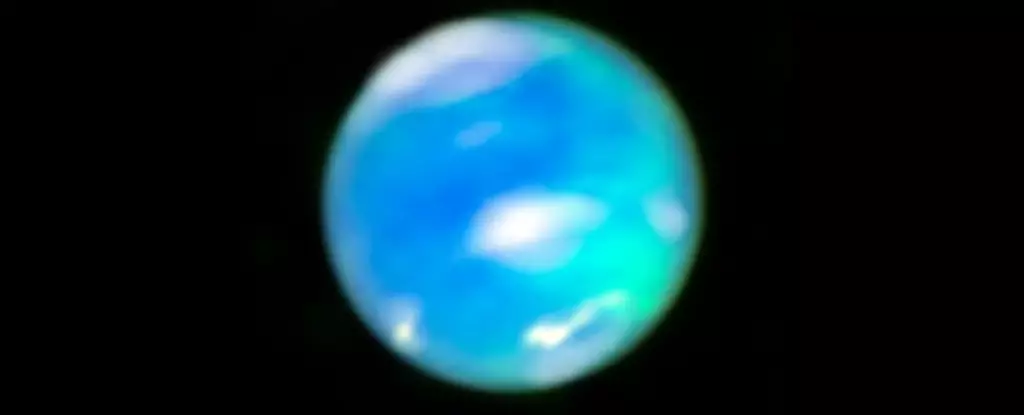The awe-inspiring beauty of planetary auroras has captivated astronomers for generations, painting vibrant displays in the skies of distant worlds. The recent revelation of an aurora on Neptune, the furthest recognized planet in our Solar System, serves as a remarkable highlight in the annals of astronomical exploration. For the first time, this elusive celestial phenomenon has been captured in breathtaking detail, thanks to the James Webb Space Telescope (JWST). As we illuminate the secrets of our universe, Neptune’s ethereal glow expands our understanding of auroras, marking a significant milestone in planetary science.
The Science Behind Auroras: A Celestial Ballet
Auroras are magnetic displays resulting from complex interactions between solar winds and the magnetic fields of planets. On Earth, these dazzling lights oscillate in a kaleidoscope of colors, as charged particles from the Sun collide with atmospheric gases, igniting a spectacular scene. However, each planet showcases its own version of this bewitching display, influenced by varying atmospheric compositions and magnetic field configurations.
Neptune’s auroras, like those on its neighboring gas giants Jupiter and Saturn, reveal a different aspect of this cosmic ballet. While Jupiter boasts some of the most high-energy auroras, Neptune’s newfound soft blue glow suggests a gentler interaction with solar particles. Each discovery of these celestial phenomena allows scientists to connect the dots between planetary characteristics and their auroral displays, thereby constructing a cohesive picture of how solar winds interact with distant atmospheres across our Solar System.
Breaking New Ground: JWST’s Groundbreaking Findings
Intriguingly, the detection of Neptune’s auroras hinged on the intense sensitivity of JWST’s powerful near-infrared spectrometer. In 2023, the telescope provided exceptional data that unveiled the presence of the trihydrogen cation (H3+), a key indicator that signals auroral activity. This marked a vital step towards comprehending how Neptune’s atmosphere reacts to cosmic elements. A team led by astronomer Henrik Melin employed this data to trace the auroras’ locations on the ice giant, leading to an astonishing revelation: unlike Earth, which sees auroras congregate around the polar regions, Neptune’s auroras appeared near its equator.
Such unconventional positioning probes into Neptune’s chaotic magnetic field, which exhibits an asymmetrical shape unlike the neatly aligned fields of Earth. This being said, the uniqueness of Neptune’s magnetic configuration challenges preconceived notions about how solar winds influence planetary atmospheres, prompting scientists to rethink existing models that describe such interactions.
An Unexpected Twist: Temperature Insights and Historical Context
The JWST’s findings also uncovered a striking detail regarding Neptune’s temperature. Previous measurements from the Voyager 2 mission suggested a warmer Neptune, leading researchers to misinterpret the planet’s auroral visibility. With JWST’s data hinting at a cooler state since the late 1980s, it became clear that the planet’s inherent chill had a direct correlation to the faintness of its auroras. This underscores a significant lesson in scientific inquiry: hypothesis grounded in incomplete data can lead researchers astray.
Understanding Neptune’s current atmosphere allows astronomers to redefine their aurora detection strategies not only on our distant Solar System neighbor but on exoplanets residing in other stellar enclaves. This fresh perspective emphasizes how vital accurate temperature readings are when observing heavenly bodies, a theme that resonates through the corridors of planetary science.
Implications Beyond Neptune: Insights into Exoplanetary Systems
The discovery of Neptune’s auroras not only enriches our knowledge of our Solar System but also opens new windows into the study of exoplanets. As we learn about the magnetic and atmospheric dynamics of our own planets, the understanding gained can be juxtaposed with distant, potentially habitable worlds orbiting other stars. These insights can serve as a template for interpreting auroral activity on exoplanets, offering clues about their habitability and magnetic environments.
In weaving together the rich narrative surrounding planetary auroras, Neptune’s ethereal display reminds us of the intricacies within our universe. As astronomers continue to unravel the mysteries of these cosmic spectacles, they enrich our appreciation for the delicate interplay between solar forces and celestial bodies, inviting us to ponder what other wonders still lie beyond our gaze.

